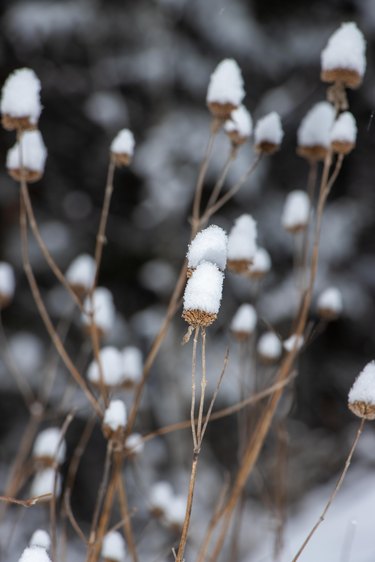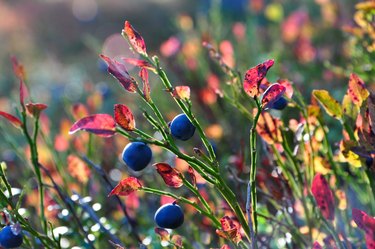
As summer fades with its poignant descent into fall, some plants take up the challenge. We all love the gold and red tones of autumn, but they aren't the only palette wielded by plants and flowers as fall approaches.
Consider incorporating some of these beauties this fall, and some may bloom or produce color well into winter.
Video of the Day
Video of the Day
Perennials for Fall Color
Most gardeners know that asters and mums are awesome late summer/fall bloomers — and they are abundant in the fall in nurseries and big-box stores, so you can't miss them — but let's talk about a few flowers that might be less known as fall bloomers.
Purple Mexican Bush Sage
Also called velvet sage, the deep violet blooms of Mexican bush sage (Salvia leucantha) appear atop 2- to 3-foot-tall stalks, usually arching gracefully as the plant grows in size. If you're going for hummingbirds or butterflies, this is for you.
This plant is sometimes grown as an annual in climates outside of its hardiness zones.
Mexican Bush Sage Environment and Care
- Size: Up to 3 feet wide and tall
- Hardiness zones: 7–10
- Light: Full sun or partial shade
- Flowering time: Summer through fall
- Care tips: Requires well-draining soil but will grow in a range of soils from loam to sand
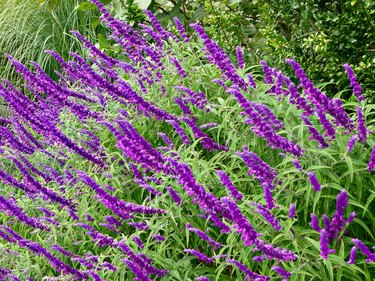
Anise Hyssop
Anise hyssop (Agastache foeniculum) is another purple blooming flower, but it's more upright than salvia. And it's edible! Yes, its name "anise" is not just for fun because its foliage does indeed smell and taste like licorice and is used as flavorings, while its seeds are also edible and are baked into cookies and muffins.
Anise Hyssop Environment and Care
- Size: 3–5 feet tall and 1–3 feet wide
- Hardiness zones: 5a –
9b
- Light: Full sun to partial shade
- Flowering time: Late summer through fall
- Care tips: Requires well-draining soil and can handle occasionally dry conditions
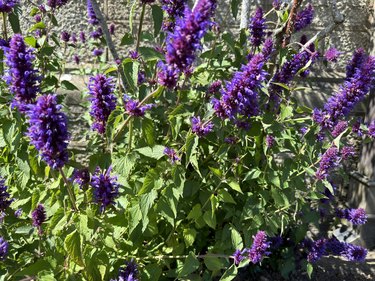
Autumn Sneezeweed
There's a reason behind its evocative name. This plant actually has been used to create a type of snuff that can make its users sneeze. (All I can say about that is "huh?" because who would purposely stick that anywhere near their nose?) Understandably, it's also called bitterweed.
Cultivars of sneezeweed (Helenium autumnale) are far more beautiful than the common sneezeweed that can be found natively in several areas of the U.S., so see what you can find at local or online nurseries. Consider Moerheim Beauty for a lovely orange color and Striatum for yellow flowers with orange centers.
Sneezeweed Environment and Care
- Size: 3–5 feet tall and 2–3 feet wide
- Hardiness zones: 3–8
- Light: Full sun to partial shade
- Flowering time: Summer through fall
- Care tips: Requires moist soil and enjoys clayish conditions and even standing water. To encourage more fall blooms, prune back this plant in early summer.
- Warning: The common sneezeweed variety has poisonous leaves, flowers, and seeds.
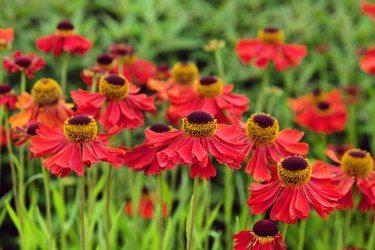
Crimson Glory Vine
This one's a vine and a real stunner. If you have a large wall or a fence with a lot of room around it, crimson glory vine (Vitis coignetiae) could be for you. Unlike some climbing vines, it doesn't put out sucker discs that adhere to a surface and thereby damage it; rather, it has tendrils that seek and find strongholds since it is a species of grape, although primarily ornamental. (It does produce small, bitter fruit that birds may eat, but I don't suggest trying them.)
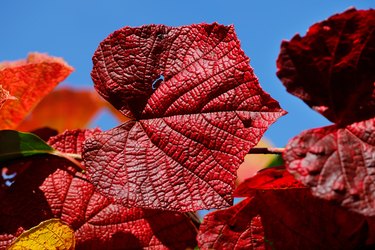
I was hankering after this plant and finally found it at a nursery. I bought it, brought it home, and then did more homework on its characteristics. This is a big vine and will climb up a nearby tree in no time. It won't smother the tree, and it's not a parasite, but it will use it to ascend up to 30 or 40 feet if it can.
I decided that I don't have room for this — but I so much wish I did because I've rarely seen such a magnificent display. Maybe you have a large backyard tree that would look great in fall wearing these crimson colors.
Warning
If you love this vine's fall color and are looking for a substitute, you might come across a similar vine with gorgeous red fall leaves, and that's Virginia creeper. That vine has pretty high poisonous characteristics, so if you have pets or children, it's wise to stay away.
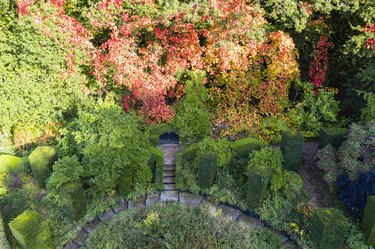
Annuals for Fall Color
Many annuals can be coaxed to bloom all summer and well into fall, especially if you pinch them back in mid to late summer to encourage new blooms. And deadheading is a must!
Focus on more hardy annuals for the longest bloom period
You might want to focus on somewhat hardy annuals if you live in a colder clime so an early frost doesn't wipe them out, but there are many tender annuals that will join a fall chorus of color until they give it up at frost.
You can extend a less hardy annual's song if it has a lot of sun and is shielded from harsh winds.
Ubiquitous among fall and cold-hardy annuals are pansies, violas, cosmos, marigolds, and sunflowers, but we'll focus here on flowers that are not as well-known or that might not be commonly identified as fall bloomers.
Snapdragons
Some gardeners may not realize how cold-hardy many snapdragons (Antirrhinum majus) are because you always see them having a party in a summer garden. But these cheery flowers atop tall stalks can be grown as perennials in warm climates. They will wilt in very hot weather, however, so pinch them back in the summer, give them plenty of water, and watch their fall display.
Their color and size vary widely, so you'll have a lot of options when choosing varieties.
Snapdragon Environment and Care
- Size: Can range from 6 inches to 3 feet in height with a width up to 10 inches
- Hardiness zones: 7–10
- Light: Full sun to partial shade
- Flowering time: Early summer through fall
- Care tips: Requires well-draining soil. To encourage more fall blooms, pinch back in summer.
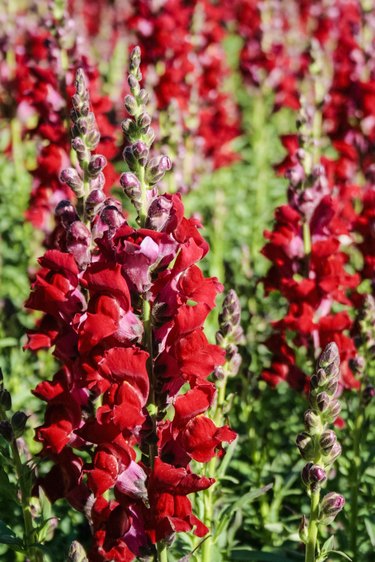
Twinspur (Diascia)
Twinspur (Diascia barberae), also called Barber's diascia, is classified as a half-hardy annual and sometimes a perennial, but it requires a pretty warm climate to winter over. This plant has pink blossoms on 12-inch-tall stems that form a dense mat. If you prune it way back in summer, it will likely thank you because it will probably stop blooming in the heat anyway. But then it will be primed to give you a display in the fall.
A perennial variety of twinspur is entire-leaved twinspur (Diascia integerrima), which can be grown down to zone 6 and has red flowers.
Twinspur Environment and Care
- Size: 12 inches tall and 18 inches wide
- Hardiness zones: 8–11
- Light: Full sun to partial shade
- Flowering time: Spring and again in fall
- Care tips: Requires rich, well-draining soil with high organic matter
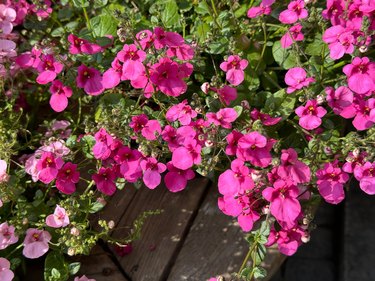
Verbena
Usually purple, verbena comes in all sizes and shapes. Some are ground covers, some are great for trailing plants in baskets (Glandularia canadensis), and some are quite tall with upright stalks. The latter is familiar as purpletop vervain (Verbena bonariensis) and can reach 4 to 6 feet tall. These are just a few examples of the verbena plant, but all are long-flowering well into the fall.
These are easy to grow and will gift you with blasts of color for many months.
Verbena Environment and Care
- Size: From 8 inches to 5 feet tall
- Hardiness zones: 7–9
- Light: Full sun
- Flowering time: Spring, summer, fall
- Care tips: Requires well-draining, rich soil and regular moisture. Aim for a somewhat acid pH (<6.0). Prune back by 1/4 of its height in summer to encourage fall blooms.
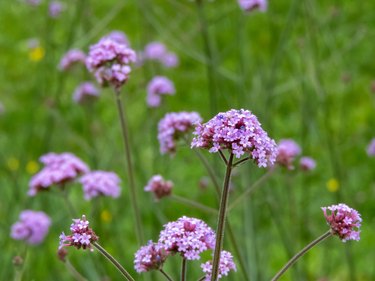
Shrubs for Fall Color
Shrubs are a more permanent solution in a garden design, but if you have room for more or you wish to transplant some to make room for more fabulous fall color, here are some great choices. Some primarily feature leaves, while some have both flowers and leaves that shine in fall.
Oakleaf Hydrangea
Oakleaf hydrangea (Hydrangea quercifolia) is the queen of fall color to my mind. And not only are the leaves a marvelous crimson but the flowers become a dusky pink and last well into late fall if you don't have a killing frost.
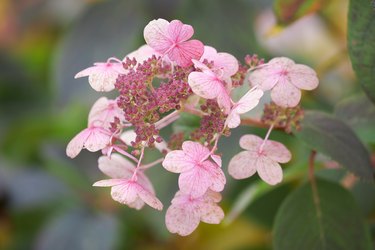
Oakleaf Hydrangea Environment and Care
- Size: 4–8 feet tall and wide
- Hardiness zones: 5–9
- Light: Full sun to partial shade
- Flowering time: Spring, summer, fall
- Care tips: Requires well-draining, moist soil. If you let this plant dry out, blooms will be scarce and small.
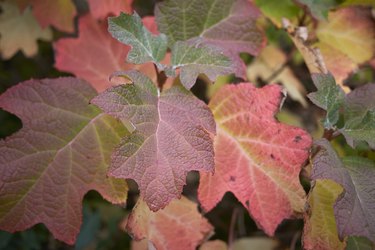
Barberry (Not What You Think)
We all love red and gold barberries, but that's not what I'm talking about here. The genus Mahonia has recently been subsumed into the Berberis genus, so this plant, while quite different from the barberries we all know, is now called a barberry.
On Mahonias
The Mahonia genus (now part of the Berberis genus) includes about 70 evergreen shrubs and trees, among which Oregon Grape may be the most well-known. Oregon Grape (Berberis aquifolium, previously
Mahonia aquifolium) is, as its name suggests, native to Oregon. Oregon Grape, however, flowers in the spring.
With its golden yellow, receme-type flowers that appear in fall, this evergreen plant can stake an impressive claim among fall-flowering shrubs. Plus, it smells marvelous.
Mahonia (Barberry) Environment and Care
- Size: 4–5 feet high and 3–4 feet wide
- Hardiness zones: 7–10
- Light: Prefers full sun but can tolerate some shade
- Flowering time: Fall, followed by berries
- Care tips: Requires well-draining, alkaline (> 8.0) soil. Prune lightly because this plant will produce blooms only on old wood the following year.
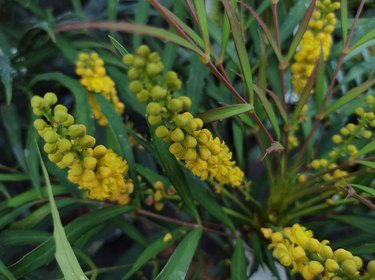
Fall Witch Hazel
Fall witch hazel, called so because it flowers in the fall, is one of several species in the Hamamelis genus, but only fall witch hazel (Hamamelis virginiana) flowers reliably in the fall. Vernal and hybrid varieties flower in late winter.
This is a native shrub, and so it is particularly useful to birds and other pollinators. It can get large, so make sure you have enough room for this plant if you decide you must have it.
Fun fact: Witch hazel did not get its name because its bloom period coincides with the annual arrival of witches for Halloween, as I first assumed! (Yeah, I know. Call me naive.) Rather, its branches were used for "water-witching," in which (no pun intended) they would bend if they detected water — at least, that was the belief.
Witch Hazel Environment and Care
- Size: 15–30 feet high and 15–20 feet wide
- Hardiness zones: 3–9
- Light: Full sun to partial shade, but the blooms will be more profuse in sun
- Flowering time: From late fall to late winter
- Care tips: Requires well-draining, moist, clayish soil and can handle some occasional flooding
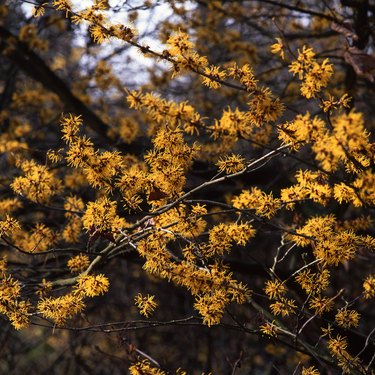
Fall "Don'ts" to Support Wildlife
Throw away your rake, your leaf bag, and your pruners — I mean, really. I love a neatly raked, clean yard as much as anyone, but we can support pollinators and other wildlife if we let things be for a while.
Stalks, stems, leaves, and seed heads make a marvelous habitat and food for the various critters who must make it through the winter. For example, many kinds of bees make homes underground in winter, and that pile of leaves you are itching to haul away provides them protection from the cold. Seed heads are valuable sources of food for birds.
Of course, you'll want to remove leaves from your lawn because the lawn will suffer, but instead of bagging them and putting them out on the curb, spread them onto your perennial beds.
Waiting to do yard cleanup is also good for plants. For instance, most woody plants do better if you prune in late winter rather than fall because they don't have the energy to close up fresh wounds before killing frosts and freezes occur. Save most of your garden chores for late winter or early spring and know you're supporting healthy plant growth and also being a good neighbor to wildlife.
